The history cook: Food of Christmas past
Simply sign up to the Life & Arts myFT Digest -- delivered directly to your inbox.
It is a cold and misty November morning in the Lake District, and I am standing in a 17th-century farmhouse in a low-beamed room in front of what looks like a medieval instrument of torture. The room is warm and the air is rich with the smell of spices and roasted meat. My mouth starts to water and my stomach rumbles. At both ends of the room are lit ranges and around the sides are shelves covered with copper pots, jelly moulds, silver cutlery, feather pastry brushes and culinary tools whose function is lost in time. This is not a museum display but the home of food historian extraordinaire Ivan Day. The room I am in is Day’s “experimental laboratory” and he has invited me here to explore the food of Christmas past.
Quince tart
Scroll down for method and ingredients
Serves six
The instrument of torture, 5ft long, replete with iron bars and tightening clamps, turns out to be an 18th-century cradle spit, ingeniously designed to hold a piece of meat steady while roasting in front of the fire. We are using it to cook gigot of mutton stuffed with orange, a Christmas dish from the first written record of a Christmas menu or bill of fare: Robert May’s 1660 The Accomplisht Cook.
. . .
Christmas Food & Drink special
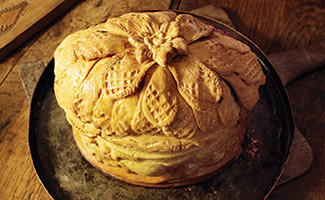
Gift guide
Ideas for family and foodies
A pint and a partridge
Gourmet pub recipes
The taste test
Chocolate coins and seasonal lattes
Nicholas Lander
Restaurant highlights of the year
Jancis Robinson
Christmas red wines
Food classes
The gift of gastronomy
Rowley Leigh
Party starter: Christmassy snacks
Here’s looking at you
Quick wintry cocktails
FT Masterclass
Cheese and wine pairing
Day’s interest in historical cookery started when, aged 13, he ducked into an antiquarian bookshop in Colchester to shelter from the rain. He picked up a battered copy of John Nott’s 1723 The Cooks and Confectioners Dictionary and was hooked: “I loved the language. I thought it was funny – to ‘cook a sucking pig’ or ‘to broil a lump’ [lumpfish].” Soon he was spending all his pocket money on historic cookery books, and in the holidays he tried out the recipes on his parents. Day has been experimenting with historic food ever since – he runs food courses throughout the year and advises museums and archives on their collections and exhibitions. When he talks about the subject, it’s not hard to imagine him as a young boy – his eyes sparkle, he brims with enthusiasm and he can’t wait to show me his strange cookery gadgets: “I’ve spent a lifetime trying to equip a kitchen to cook British food as it really was, and what I’ve found is a revelation: people in the past ate much better than us!”
Mutton seems a strange choice for Christmas but, as Day explains, the roasted poultry we associate with traditional Christmas dinner would only have been one part of a bigger feast: “Medieval people would roast fowl, geese and wild birds throughout the year but especially at Christmas because they were at their fattest. Cygnets were a special Christmas dish because they hatched in June and were plump and tender by December.” As early as the 16th century, farmers were advised to grow turkeys for the Christmas table but it was modern farming that really established it as the definitive Christmas bird. “Geese are hard to farm but turkeys are meat factories,” explains Day. “What we eat now at Christmas is more about economics than taste. We’ve whittled dinner down to three courses of three or four dishes but in the past, a Christmas feast would’ve been two courses of more than 20 dishes each.”
Trained as a botanist, then an art historian, Day’s explorations – testing, experimenting and replicating – are informed by his scientific training and his appreciation of the decorative arts. “Cooking is as much about design as it is about food,” he says. For Day, the recipe is just a starting point: “I realised when I started cooking you couldn’t replicate this food without the equipment, without understanding the tools and techniques that were used.”
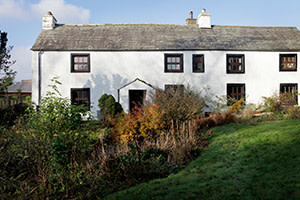
Handing me a 17th-century knife, Day demonstrates how to cut even strips of orange peel before reaching for an 18th-century case containing about 20 silver “larding needles” of various lengths. The needles open out at the thickest end into a series of metal claws, so that a slice of fat or peel can be held in place. “Every cook would’ve had a set of these,” Day explains, forcing the needle through the layer of fat around a large leg of Herdwick mutton. A strip of peel is now threaded through the fat, poking out at either side. He hands me the needle. I add another piece of peel, then strain to push in through the mutton. When I finally pierce the fat I manage to pull the peel out with the needle, leaving a large, empty hole. I discover what becomes a consistent theme: Day is skilled while I’m cackhanded.
When the peel is threaded, Day takes the mutton and places it in the middle of the cradle spit. “It looks like edible embroidery,” he says with glee. He turns the clamps at either end of the spit to hold the mutton in place and forces two thick skewers into the meat to secure it. “These skewers were forged out of testosterone, they’re not like those spindly things we use now.”
Day lugs the spit over to the other end of the room and positions it in front of the open range with its 2ft pile of molten red coal. It’s like looking into the gates of hell – the heat from the fire melts my mascara from 6ft. Above the fire and to the right is a weighted 1780s spit-jack which Day connects to the cradle with a length of chain. Invented in Italy in the 1500s, the spit-jack automated a dangerous, difficult job that had previously fallen to the lowliest members of the kitchen: young boys. Day winds up the spit, the mutton starts to turn and the room is filled with the sound of a 17th-century kitchen – grinding cogs, creaking chains, a crackling fire and sizzling meat.
“This is the lost art of roasting meat, what the English were famous for,” Day says. “It relied on a mixture of experience and intuitive knowledge.” Fuel was the most costly part of household expenditure, so roasting came to be associated with wealth and hospitality. The rich displayed their affluence with vast fireplaces where, for feasts, three or four spits would roast a selection of meats. “This cooking involved great skill in timing and fire keeping. In the medieval period, before clocks were available, cooking time was sometimes measured out by the duration of prayers.”
Underneath the mutton, Day places a copper pan filled with a mixture of mashed potato, raw onion, cloves, black pepper and copious amounts of nutmeg and butter. “This is my very favourite historic recipe,” he says. “It’s a 1773 Scottish recipe for ‘a common potato pudding to be fired below roasted meat’ from Mrs Maciver’s book Cookery, and pastry.” Below the pan is a vast, copper-bottomed basting pan, about 3ft square. The mutton takes an hour and a half to cook and during this time Day, standing at a distance to avoid the fierce heat, regularly bastes the meat using a 2ft long ladle.
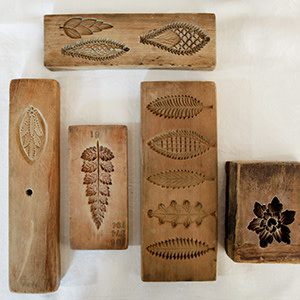
Day now turns his attention to a closed range at the other end of the room. In the larger of its two ovens is a Christmas pie that we prepared first thing. This transports us two centuries forward to the Victorian period. “Much of what we think of as an age-old Christmas tradition actually only dates back to the Victorians,” explains Day. “They had a nostalgic attitude towards the medieval period – you can see it in their Gothic-revival churches and castles and art, and you can see it in the ways they mythologised medieval Christmas.”
. . .
It was Queen Victoria who championed the trend for a side-table of cold dishes such as brawn, ham and game pies. The Christmas pie in Day’s oven dates from the 1800s but has its origins in medieval feasting. There are records from the Salters’ Livery Company from the late 14th century describing a Christmas bird pie decorated with head, wings and tail. Recipes in the 18th century, notably by Hannah Glasse, describe a pie filled with a turkey stuffed with a goose stuffed with a fowl stuffed with a pigeon – a historical forerunner to the “turkducken” perhaps. Once cooked, pies were sometimes pierced at the bottom, drained of their gravy, then filled with butter so they could be stored in the weeks ahead of Christmas. “This was an early form of canning,” says Day, “and it also meant pies could be sent as gifts on journeys.”
By the Victorian period the Christmas pie was a centrepiece of the cold table, set out every day of the holiday until it was gone. Some of the recipes are extraordinary, such as Chef Francatelli’s 1846 Christmas recipe, made with truffles, a turkey, a brace of pheasants, four widgeons and a small York ham. It took two days to prepare and six hours to cook. “If we made it today the ingredients would cost in excess of £300.”
The pie in Day’s oven is smaller but impressive nonetheless. It includes a pair each of turkey, pigeon and duck breasts with a forcemeat made from minced turkey, parsley, thyme, ground long pepper, nutmeg, cloves and mace. Day grinds the spices in a 3ft-high pestle and mortar, “a 16th-century food processor”, before adding them to the mince with plenty of salt.
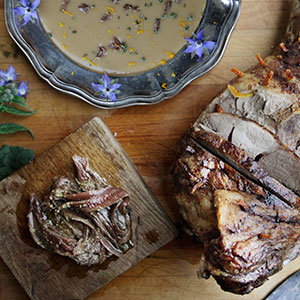
Meat prepped, Day rolls out and cuts a thick slab of pastry and then reaches for an oval Victorian pie mould, intricately decorated with fruit, vines and leaves. Lined with tin inside, the copper mould has a removable base and a hinge on the side so that it can open out. Day paints the inside with butter then lines it with pastry, a task that demands courage and care. Once the mould is locked in place, Day starts to press the pastry into its sides. “This is Zen and the Art of Pie Making! You have to feel for the design. It’s easy to miss the fine indents.” Once he’s satisfied, Day fills the pie, starting with forcemeat, following with the seasoned breasts and finishing with another layer of forcemeat. The filling rises above the rim by a good 15cm by the time Day covers it with pastry. “A tribute to Sir Christopher Wren I think!” he chuckles.
This pie already looks impressive but Day is just warming up. He disappears to the other end of the room and returns with two hand-carved 19th-century “pie boards”. Each has a series of leaf patterns, as intricate as lace. Day teaches me how to roll out and press pastry into the patterns to create perfect leaf decorations, and places two layers of the leaves around the pie dome.
We’re still not done: “The most important part is to seal the sides and top together well.” Day has a “crinkumcranks jagger” to hand, a tool which has a wheel-like spur at one end and rivets at the other. “Everyone is born with a set of pastry tools,” Day says, waving his fingers as he sets about using the jagger and his thumb to create a seam resembling a beautiful petticoat ruff. “The British love their pies but they’ve forgotten how to make them. These kitchen skills are lost,” Day says wistfully.
. . .
By now the mutton has been roasting for an hour. The room is filled with a rich, savoury smell but there is none of the smokiness I assumed would characterise a fire-fuelled kitchen. “We do the people of the past a disservice to think of them as primitive,” says Day. He shows me a child’s eating knife from 1570 inlaid with brass, a peasant’s knife from 1400 made from bone and iron with hearts cut out in the handle, and a 17th-century silver sweet-meat fork. “These were carried around by their owners, flaunted and displayed. They were the period’s equivalent of the latest iPhone.” They make our cutlery look very basic indeed.
For Day, the assumption that only the wealthy ate well in the past is also overstated. Though the poor sometimes had a basic or depleted diet, they had a rich folk culture of cooking. “Don’t forget, the poor were making food for the rich. There were no cooks from wealthy families. It was the poor who were innovators in the kitchen.”
Day finishes off with two tarts. One is from a recipe he collected from an 80-year-old farmer’s wife “for the very last mince pie that had meat in it”; the other is a 1707 quince lattice pie. Starting with the mince pie, Day takes a bowl of homemade mincemeat (the sweet type we use today) and mixes into it minced lamb and a generous grating of nutmeg. “These were first called ‘mince pies’ in the 16th century but before that they were known as ‘shred pies’. They were made with tongue, offal or veal mixed with suet, dried fruits and sugar,” Day says. “In Cumbria these sweet pies were partially eaten on Christmas morning and then saved until Candlemas morning on February 2.” Day lines a tart tin with pastry, fills it with the mincemeat, covers it with pastry and uses a pastry comb and stamp to decorate the top.
For the lattice pie, Day sets me peeling and chopping seven poached quinces. “We used to make quince recipes routinely in England,” he says. “The fruit are in season from October to December, so they were often a feature of Christmas menus. This tart is the very essence of Christmas.” Once chopped, the flesh is set aside while peelings and cores are placed in a copper pot with water and sugar and put on the hot side of the range to make a “quidany” or quince jelly for the tart.
When the quidany has turned syrupy and deep orange, Day strains it and puts it aside to cool and set. He lines a tart dish with pastry and fills it with the quince pulp and the quidany. This recipe comes from a cookery book called The Whole Duty of a Woman. “In the 18th century it was acceptable for gentlewomen to make confectionery and pastry work – it was considered to be like embroidery,” Day explains. Using a “pastry jagger” with a riveted wheel, he cuts out about 22cm-wide strips long enough to cover the diameter of the tart. He places these on a piece of greaseproof paper and starts to weave them into a lattice grid. To get this structure on to the top of the tart Day places the sheet of paper over the top of the pie and whips it away like a comedy tablecloth pulled from under a dinner setting.
It is getting dark when the two tarts go in the oven. “This is not restaurant food,” says Day. “It’s the original slow food. It takes time to prepare and to cook.” By now the Christmas pie, mutton and potatoes have finished cooking. The pie needs to cool before it can be sliced but the mutton, looking gloriously baronial, and the potato, which now has a dark brown crust, are ready to eat. Just as I am about to launch myself on the mutton, Day decides to whip up a sauce made from thickened lamb stock and anchovies, which he serves on a 17th-century silver plate and decorates with borage from his garden.
. . .
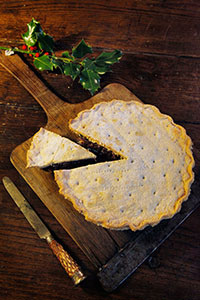
Finally, Day takes up his carving knife and cuts me a slice of mutton. The orange peel on the outside has caramelised to a bitter marmalade ooze, the skin is crisp and dark and the flesh faintly pink and mouthwateringly tender. No roast I have ever tasted comes close to this. “We tend to think cooking with fire is primitive but the technology of the oven can’t make food taste better. Compared to a fire, an oven doesn’t really work for roasting. The dry, relentless heat evaporates all the moisture. On a spit the meat gets intense, radiant heat then rests. It gets to the optimum temperature slowly,” Day tells me. I pretend to listen but I’m deep in reverie, thanks to a mouthful of the potato. It tastes like a deeply flavoured, edible cloud.
The room glows warm with firelight and the copper pots, silver platters and cut glasses that fill every surface in the room gleam and sparkle. A slice of quince tart tastes perfumed and sweet, like Turkish delight, and the mince pie is warming and satisfying. But his piece de resistance, the Christmas pie, has not cooled in time for me to taste. Perhaps this gives me an excuse to return.
For all his passion for history, Day is not sentimental about the past. Nor does he retreat from the present. His wife Jill assures me there are tins of baked beans in their other kitchen, the one they use for the everyday. “I don’t want to go back and live in the past,” he says. “It wasn’t a wonderful place. I want to live now and for me, having this historical festive feast that spans the centuries suits me just fine.”
Polly Russell is a curator at the British Library
Quince tart
by Ivan Day
The inclusion of a quince tart in Robert May’s 1660 Christmas Day bill of fare was the reason for choosing this dish. However, the recipe I have selected is from The Whole Duty of a Woman, first published in 1701. It is a fairly ambiguous recipe, indicating that you can make either a raised pie (coffin) or a tart. I opted for the tart in my modern version. A cut cover was a tart or pie lid that was ornamented with intricate knotted designs, the only surviving vestige of this kind of pastry work being the lattice cover.
Quince-Pye: or Tart
Boil your Quinces in Water, sweetened with Sugar, till they be soft, then skin them and take out the Cores; after that boil the Water with a little more Sugar, Cloves, Cinnamon and Lemon peel till it becomes of the thickness of a Syrup; when cold lay your Quinces in Halves or Quarters, scattering Sugar between each Layer; put a pint of the Syrup, or more according to the Biggness of your Pye or Tart, make the Coffin round with close or cut Covers, and bake it pretty well. And thus you may do with Pippins and Pearmains, or with Winter-Fruit, and also with green Codlings.
Here is a modern version
- Rub the butter and lard into the flour until it comes to the texture of breadcrumbs.
- Using a blunt knife, cut just enough water into the mixture to bring the pastry to a consistency that will hold together, without being too crumbly or too wet. The exact amount of water depends on the nature of the flour. Allow it to rest for at least half an hour.
- Roll out about half the pastryand use it to line a buttered 30cm pie plate.
- Put the whole, unpeeled quinces into a large saucepan. Half cover them with water. Put the lid on tightly. Bring to the boil. Turn down the heat so they just simmer. Poach them until they are cooked through to the core – about 35-40 minutes (test with a skewer). Once cooked, remove the quinces and let them cool. Peel them. Put the peel back into the cooking water.
- Cut the flesh off the quinces in small slices until you get to the cores. Arrange the slices in the pastry case.
- Cut the cores in two and put them back in the water with the spices and lemon peel. Boil the water with all of the quince peel and cores until it reduces to about a third. Strain it, pouring the strained liquid back into the saucepan. Add 170g of the sugar, stirring gently until it dissolves. Gently cook, stirring occasionally. After an hour the mixture will turn to a bright red, thick jelly. Once cool, distribute spoonfuls of it among the quinces in the pie case. Do not overfill. Scatter the quince filling with the remaining sugar and cover the tart with a lattice top or plain cover, made from the rest of the pastry. Bake at 180C for 35-40 minutes.
For more information go to Ivan Day’s website
Comments